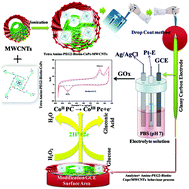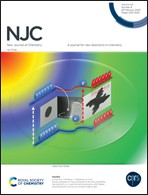The electrochemical investigation of carboxamide-PEG2-biotin-CoPc using composite MWCNTs on modified GCE: the sensitive detections for glucose and hydrogen peroxide
Abstract
The electroanalytical study of a synthesized novel tetra-cobalt(II) carboxamide-PEG2-biotin phthalocyanine (CoTPEG2BAPc) composite with MWCNTs to create a biosensor with a high response to glucose in the presence of H2O2. The glucose biosensor can be easily detected by casting onto GCE, and and it displays intrinsic electrocatalytic ability for the enzymatic oxidation and reduction of glucose and H2O2, showing higher catalytic activity than that of a bulk CoTPEG2BAPc electrode. Under optimal conditions, the biosensor shows a wide linear response to glucose (CV: 2–16; DPV: 2–22; CA: 5–50 μmol) and H2O2 (CV: 5–25; DPV: 2–22; CA: 5–50 μmol), good sensitivity towards glucose (CV: 0.947; DPV: 1.978; CA: 0.101 μA μM−1 cm−2) and H2O2 (CV: 1.250; DPV: 1.888; CA: 0.162 μA μM−1 cm−2), and a stable long-term life and LOD for glucose (CV: 0.33; DPV: 2; CA: 12.5 μmol L−1) and H2O2 (CV: 1.5; DPV: 5; CA: 10 μmol L−1). The amperometry selectivity studies involving different biomolecules, including AA, DA, UA, L-cysteine, and glycine, show that they do not affect glucose and H2O2 determination. Our present work exhibits very attractive and practical performance for biosensor applications.



 Please wait while we load your content...
Please wait while we load your content...